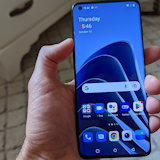 The HTC Rhyme is a mid-range Android 2.3 Gingerbread device with which HTC has taken a slightly different approach when it comes to aesthetics and accessories. The HTC Rhyme also comes standard with its own unique charging dock, which allows the phone to operate as a bedside clock with integrated web, weather and notifications. We grabbed a hold of one and took it for a spin to see how the Rhyme compared to other devices in the same field in our HTC Rhyme review.
The HTC Rhyme is a mid-range Android 2.3 Gingerbread device with which HTC has taken a slightly different approach when it comes to aesthetics and accessories. The HTC Rhyme also comes standard with its own unique charging dock, which allows the phone to operate as a bedside clock with integrated web, weather and notifications. We grabbed a hold of one and took it for a spin to see how the Rhyme compared to other devices in the same field in our HTC Rhyme review.
Physical Design of the HTC Rhyme
As far as shape goes the HTC Rhyme is very similar to other HTC phones we’ve reviewed. The iconic sloping top and base are present, as is the curved rim surrounding the device. The only really unique element to the overall design is the various colours in which the Rhyme is available. The three options are Clearwater, Hourglass and Plumb, also known as Grey & White, Aqua and Maroon.
The colour scheme gives the Rhyme an obvious appeal to folks who want something other than the traditional white or black options.
Initially the Rhyme didn’t really impress us. The general feeling we got was that HTC had recycled an older-style casing and filled it with new parts. If looked at with more than a casual glance the screen is quite small when compared to the overall size and the handset looks a little more chunky than it really needs to be. It definitely didn’t end up being an issue, but it didn’t lend itself well to early impressions.
Despite this the Rhyme was comfortable to hold against the ear or in the hand and the predominantly plastic rear of the device was surprisingly grippy. All the buttons were easily pressed but we didn’t have any accidental activations when kept in the pocket.
One small issue we did take was with the charging port cover. The phone’s Micro USB socket is protected by a small lid that is connected with two smaller rubber straps. This protective flap really doesn’t seem to serve a purpose and felt extremely delicate. We were left with the impression that this is definitely a piece that has a high chance of breaking off over the course of a contract. Of course, once it’s gone you’ve really lost nothing, as most devices don’t sport a cover like this. Nor does the flap serve to protect the Rhyme against water damage, as the 3.5mm headphone jack is uncovered and the phone itself hardly feels water-tight.
 Display and UI
Display and UI
The display of the HTC Rhyme was more than adequate. It certainly wasn’t one of the most impressive screens we’ve ever seen, but it was never intended to be. The 3.7 inch display’s 480 x 800 resolution provided a fantastic pixel density (252ppi) and while the Super LCD couldn’t provide such radiant colours as a Super AMOLED variant it still offered vibrant images and crisp, clear whites.
The UI has actually seen some changes from the standard HTC Sense UI layout that we’ve come to know and love. There are still 7 Home Screens that are accessed with left or right swipes. Zooming out still provides an overview of all screens and the screens are laid out in a continuous loop, meaning you can swipe in one direction long enough and come back to where you started.
Where the UI really differs is on the main home page. The iconic weather and time widget that has been the face of HTC’s UI for so long has dramatically changed in appearance. Instead of sporting the traditional flip-down clock style of numbers the new clock format simply shows the numbers by themselves. Weather, date and temperature are still there but, like the numbers, there is no border or backing slate upon which they are situated. The entire widget has also made a move from the top of the screen to the bottom.
HTC has also removed the ability to place applications directly on the primary home screen, instead opting for a left-hand column of pre-set apps. From top to bottom these apps are Mail, Messages, Music, Camera and Android Market. These apps have a slightly different interface than the standard icon. Instead of merely tapping on an app to activate it, each of these pre-sets has a small tab on the right side. Activating the tab will extend the tab outwards, allowing the user to quickly check the first few lines on a message or email, or manage music etc.
Unfortunately these pre-sets are in no way customisable, nor is the clock or anything else on the entire screen. As it turns out the column of apps, as well as the clock and weather service, are all part of one large, transparent widget that covers the whole page. As such any attempt to move a single pre-set or the clock itself resolved in selecting the entire widget for relocation or erasure. We have to admit this new layout is quite stylish, but it definitely loses points due to its sheer lack of customisation options.
Of course the other 6 Home Screens, being unchanged from the standard Sense UI, are totally customisable. Most will come with preloaded widgets but they are easily enough relocated or removed, making plenty of room for users to bring their apps up on to a main area.
The HTC Sense Lock Screen has made its useful appearance. By dragging the Phone, Mail, Camera or Messages icon in to the ring the user can jump straight to any of these areas. Moreover each icon will show whether or not there are any missed notifications for that particular service. This is the kind of functionality that a user can get used to very quickly and eventually one wonders how other manufacturers haven’t adopted it. Of course we are starting to see wider adoption for Lock Screen notifications and shortcuts, but in our view HTC Sense still does it best of all the UIs we’ve tried.
Music, Video and Battery Life
The HTC Rhyme handled media quite well. The music player didn’t differ from what we’ve become used to on HTC devices. That is to say, it was a functional and easily navigable experience. We would have liked the ability to skip tracks in the pull-down notification screen, rather than just being offered the chance to pause, play or jump in to the music app but otherwise we had no issues.
Video came out very well. With a resolution of 480 x 800 crammed in to a 3.7 inch screen pixilation was definitely not an issue. Obviously the smaller screen suffered somewhat when compared to a larger version, say, the 4.7 inch display of the HTC Sensation XL. However, a smaller screen generally means less battery is used when consuming video content and we found this to be true to a degree on the Rhyme. It definitely felt like we got a longer viewing experience, if only by half an hour to an hour, when watching films.
Battery life on the whole was quite good on the HTC Rhyme. At heavy-to-medium use we found that it made a full day’s charge easily. On lighter days we often had half the battery left, sometimes even more. Deleting a widget or two improved upon this even further and some nights the need to charge didn’t really feel that urgent. The day after a chargeless night always meant that we were pushing things close by sundown, but it was still nice to use a phone that wouldn’t punish you severely for forgetting to charge it occasionally.
HTC Rhyme Dock Integration
The HTC Rhyme ships with its very own charging dock in which the Rhyme can be easily lain down to begin charging without the need of plugging in any wires. However, unlike other charging stations, the Rhyme’s dock has some added functionality.
When resting in the dock the Rhyme’s UI changes to a more bedside-friendly interface. The clock and weather displays become more prominent and the music player is brought straight to the main screen. Along the bottom of the bedside display from left to right are the Applications Menu, Phone, Calendar and Brightness buttons.
This is actually a really great way of having your phone charging when in bed. Instead of just plugging it in and leaving it somewhere within reach, the charging dock gives your handset a definite and organised place on your bedside table.
Even browsing applications differs when in this mode, as only the ‘list view’ is available, rather than the default ‘tile view’. It’s also impossible to take applications from the menu and place them on the bedside Home Screen, as it is an entirely uncustomisable view.
Overall the charging dock/bedside device functionality is great. It’s nice to feel like going back to a traditional alarm clock, rather than a phone that we left lying somewhere around our bed when we fell asleep, plugged in to whatever outlet was closest. Not only that, but take that old alarm clock/music player feel and add a modern day touchscreen interface and you have yourself a really smooth feeling bedside experience.
 Hardware
Hardware
The Rhyme is a mid-range smartphone and its hardware reflects that pretty accurately. The single-core 1GHz processor, 768MB of RAM and roughly 8GB of storage are all fairly standard for a device in this range, although the RAM is a little more than we expected. Despite the slower processor, we didn’t really notice any huge impact on speed or efficiency. Only the absolutely most processor-hungry of games seemed to affect performance
Storage-wise the Rhyme only has 4GB of internal memory, with roughly 1GB of that available to the user. For this reason our Rhyme came with an 8GB MicroSD card pre-installed. Most carriers and vendors should offer a similar product to their customers but we would definitely recommending that you check first with whomever you’re purchasing yours from, just in case you find yourself with a frustratingly small amount of space.
The 5MP camera was also a definite indicator of this phone’s position in the market. 5MP is very standard for a mid-range device from the Rhyme’s general date of release. The camera on the Rhyme was a very standard 5MP experience. It offered passable shots in well-lit areas and its pictures reduced in quality the lower the lighting became. It also had a bit of difficulty capturing moving targets when in anything other than direct sunlight.
The 720p video recording was a similar experience. We’d like to caution our audience once again as to the dangers of reading too much in to the “720p” tagline for video capture. Just because you can cram a certain number of pixels in to an image does not mean those pixels will be of a particular quality. Like every “720p” video capture-capable device we’ve ever used the HTC Rhyme was a passable filming device, but we would never recommend it over a dedicated camera. It was enough to film any off-the-cuff moments, but if you’re planning to film something in advance then we would recommend you use something more substantial. Overall it was a very standard 5MP camera.
 Browsing and Messaging on the HTC Rhyme
Browsing and Messaging on the HTC Rhyme
The Rhyme’s browser was fast but, once again, not amazing. For a mid-range phone we found it to be more than functional and we found no issues that haven’t been present in more expensive or more powerful devices. Web pages loaded quickly in full coverage areas and pinch to zoom commands operated with sufficient alacrity.
Once again the 3.7 inch display did suffer somewhat when compared to a larger variant, but screen size really is an issue of personal preference rather than objective comparison. Some people prefer smaller displays, while others opt for the larger ones.
Messaging was nice an easy, as was just about anything that involved the keyboard. We did have a few problems with our fat fingers in portrait mode, once again due to the size of the display. However, in landscape we could happily type away. We did find that if we hit max speed then the device could sometimes miss a beat, but the average typist wouldn’t notice a thing; just something to keep in mind for all you speed-typists out there.
 The WhistleOut Opinion
The WhistleOut Opinion
Overall we found the HTC Rhyme to be a capable and solid mid-range smartphone. It didn’t lag when browsing or navigating menus as many of its contemporary brethren do, nor did it feel overly cheap when held in the hand.
The charging dock integration was handled fantastically and we really liked seeing a manufacturer trying something different for a change. Otherwise everything else about the phone screamed “capable”, which is really what most folks are after in a mid-range device.
We definitely recommend considering the HTC Rhyme if you’re after an Android phone, but aren’t looking to break the bank on it.
There are also some more handy Rhyme accessories you can check out, but we unfortunately didn’t get our hands on them for the review. You can check them out here if you’re interested.



Related Articles
Find Better Phones and Plans
Hundreds of cell phone plans unpacked. All the facts. No surprises.




































